Once may not be enough for Lab’s ‘Baby Jane’ parody
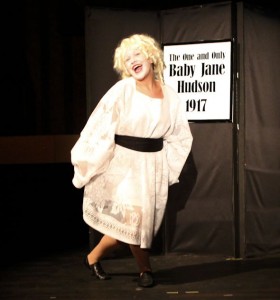 American audiences love parodies. Witness the immense and enduring popularity of spoofs such as Blazing Saddles (lampooning old time westerns), Austin Powers (mocking the 007 genre), Airplane (satirizing 1970s disaster movies), Young Frankenstein and Scary Movie. The recipe for their success starts with an abiding love and respect for the subject of their derision, and that’s keenly evident in Lab Theater’s production of Whatever Happened to Baby Jane: A Parody of the Horror, which opened June 16.
American audiences love parodies. Witness the immense and enduring popularity of spoofs such as Blazing Saddles (lampooning old time westerns), Austin Powers (mocking the 007 genre), Airplane (satirizing 1970s disaster movies), Young Frankenstein and Scary Movie. The recipe for their success starts with an abiding love and respect for the subject of their derision, and that’s keenly evident in Lab Theater’s production of Whatever Happened to Baby Jane: A Parody of the Horror, which opened June 16.
Lab’s Producing Artistic Director Annette Trossbach first learned 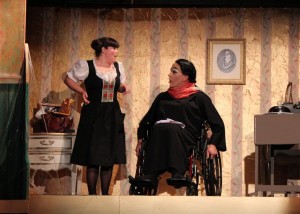 of the play when she saw the title of a play being produced for Halloween by the Hippodrome in Gainesville. “It was right on the heels of Feud,” notes Trossbach, referring to the binge-worthy 2016 FX television series that chronicled the epic rivalry that erupted between Bette Davis and Joan Crawford during and following the production of the 1962 film.
of the play when she saw the title of a play being produced for Halloween by the Hippodrome in Gainesville. “It was right on the heels of Feud,” notes Trossbach, referring to the binge-worthy 2016 FX television series that chronicled the epic rivalry that erupted between Bette Davis and Joan Crawford during and following the production of the 1962 film.
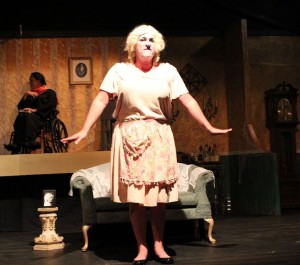 The timing could not be more perfect as summer stock at The Lab traditionally features over-the-top, zany comedies, such as Steve Martin’s The Underpants and Robert Caisley’s Happy in 2015 and Michael Hollinger’s An Empty Plate at the Café du Grand Boeuf and Deborah Zoe Laufer’s Sirens last summer.
The timing could not be more perfect as summer stock at The Lab traditionally features over-the-top, zany comedies, such as Steve Martin’s The Underpants and Robert Caisley’s Happy in 2015 and Michael Hollinger’s An Empty Plate at the Café du Grand Boeuf and Deborah Zoe Laufer’s Sirens last summer.
While the show appealed to Trossbach because of its campy, crazy, over-the-top characteristics, directing it started with character background and development. For Randall Kenneth 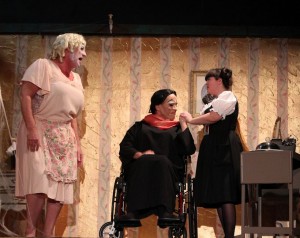 Jones and Rob Green, that meant watching the 1962 film several times to gain an appreciation of how Bette Davis and Joan Crawford portrayed their characters, including facial expressions, idiosyncratic mannerisms and Davis’ signature, stylized staccato pronunciation of words and lines of dialogue.
Jones and Rob Green, that meant watching the 1962 film several times to gain an appreciation of how Bette Davis and Joan Crawford portrayed their characters, including facial expressions, idiosyncratic mannerisms and Davis’ signature, stylized staccato pronunciation of words and lines of dialogue.
“Of course, there comes a point where you have to stop watching the movie so that you can make the part 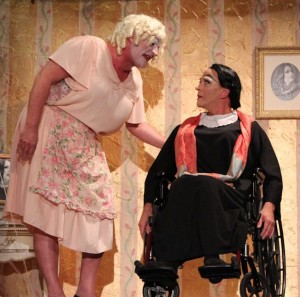 your own,” observes Jones, who plays the role of Baby Jane Hudson.
your own,” observes Jones, who plays the role of Baby Jane Hudson.
In case you’ve never seen or don’t remember the movie, Davis and Crawford were in their 50s when they were cast in the film as a pair of childhood stars condemned to obscurity in a crumbling Hollywood mansion. Davis plays Baby Jane, a vaudeville star once so beloved that her likeness was made into a porcelain doll. Unfortunately, her talents did not translate to film, a genre that favored her younger sister, Blanche. Stepping 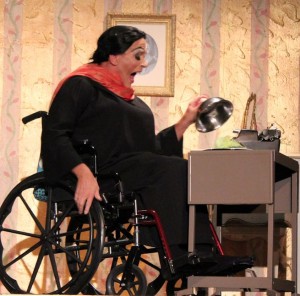 from her sister’s shadow, Blanche quickly eclipses her sister until her career is cut short when she’s paralyzed from the waist down in a tragic automobile accident that thrusts Jane into the role of caretaker. Unable to come to terms with her sister’s meteoric rise to stardom and her own relegation to the heap of Hollywood has-beens, Jane descends into madness aided by guilt, depression, delusion and rampant alcoholism. As the last vestiges of pretense and inhibition dissolve away, Jane
from her sister’s shadow, Blanche quickly eclipses her sister until her career is cut short when she’s paralyzed from the waist down in a tragic automobile accident that thrusts Jane into the role of caretaker. Unable to come to terms with her sister’s meteoric rise to stardom and her own relegation to the heap of Hollywood has-beens, Jane descends into madness aided by guilt, depression, delusion and rampant alcoholism. As the last vestiges of pretense and inhibition dissolve away, Jane 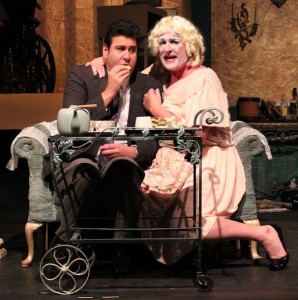 sadistically slaps, starves and tortures her trapped sister as she makes plans to revive her career and claim her sister’s money, mansion and accomplishments for herself.
sadistically slaps, starves and tortures her trapped sister as she makes plans to revive her career and claim her sister’s money, mansion and accomplishments for herself.
While the movie was billeted as a horror, the playwright (Dale Gutzman), Trossbach and her adept cast get that the movie was actually more of a melodrama. So how do you parody an already campy piece that’s an ode to exaggeration and overacting? It’s simple. You incorporate into the movie’s plot and characterizations a range of in-your-face sight gags, unabashed 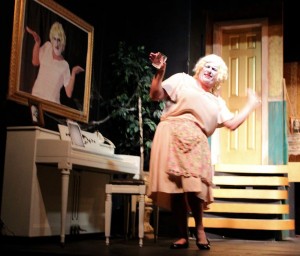 schtick and smoldering randiness.
schtick and smoldering randiness.
The show’s naughtiness transcends the fact that the Davis-Crawford leads are played by men. “There’s been a whole lot of talk about the drag stuff,” Jones admits while applying the garish full-face clown make-up that Baby Jane never removes. But while two men playing Hollywood queens admittedly amps up the play’s “spoofification (a term Jones 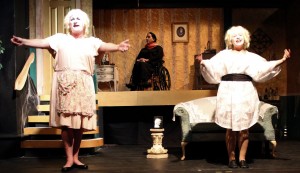 proudly coined),” audiences will discover a much sluttier version of Baby Jane Hudson than they’ve previously known.
proudly coined),” audiences will discover a much sluttier version of Baby Jane Hudson than they’ve previously known.
“Imagine if Carol Burnette got ahold of the script and took it to late night,” says Jones by way of simile. “Leave the kids at home.”
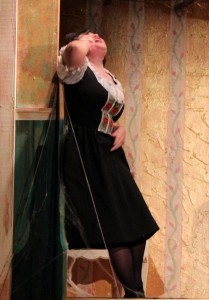 The seduction scenes he plays with piano man Jack Weld are hilarious. “Jack’s butt is a separate character in the play,” Green wryly adds. Weld and his derriere certainly induce Baby Jane to become unhinged, if not unglued.
The seduction scenes he plays with piano man Jack Weld are hilarious. “Jack’s butt is a separate character in the play,” Green wryly adds. Weld and his derriere certainly induce Baby Jane to become unhinged, if not unglued.
But Baby Jane doesn’t corner the market when it comes to sexual kitsch. As the Hudsons’ cheerful housekeeper, Elvira, Kayleigh O’Connell has a scene worthy of comparisons to Meg Ryan’s in When Harry Met Sally.
There’s also a distinctive slapstick quality to a number of scenes, especially those in which Baby Jane offs Elvira with a hammer and 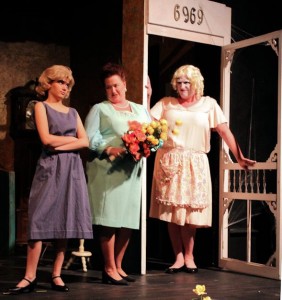 pummels a prone Blanche will taking breaks for a drink and a cigarette – handed to her by propmistress Holly Hagan standing in the wings just barely within view of the audience.
pummels a prone Blanche will taking breaks for a drink and a cigarette – handed to her by propmistress Holly Hagan standing in the wings just barely within view of the audience.
But it is not all high jinx and antics. Whatever Happened to Baby Jane: A Parody of the Comedy is a technically sophisticated show. From its well-conceived three-level set to the 88 light cues and 70-odd sound cues, there’s so much going on during this 90-minute show, you may have to see it two or three times to take it all in.
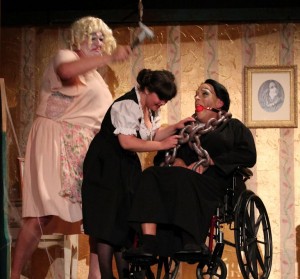 So catch this show early because you’ll want to return for an encore. Like Blazing Saddles, Austin Powers and the other parodies mentioned earlier, you won’t be able to get enough of this cult classic spoof.
So catch this show early because you’ll want to return for an encore. Like Blazing Saddles, Austin Powers and the other parodies mentioned earlier, you won’t be able to get enough of this cult classic spoof.
June 19, 2017.
RELATED LINKS.
- Lab Theater spoofing ‘Baby Jane’ horror film
- Here’s Charles Runnells review for the Fort Myers News-Press
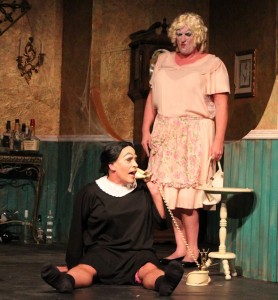 ‘Baby Jane’ parody play dates, times and ticket information
‘Baby Jane’ parody play dates, times and ticket information- Rob Green plays Blanche in ‘Whatever Happened to Baby Jane: A Parody of the Horror’
- Patrick Erhardt is Mrs. Bates in ‘Whatever Happened to Baby Jane: A Parody of the Horror’
- Jack Weld plays Edwin Bates in ‘Whatever Happened to Baby Jane: A Parody of the Horror’
- Steven Coe part of cast of ‘Whatever Happened to Baby Jane: A Parody of the Horror’
- Holly Hagan back on stage at The Lab in ‘Whatever
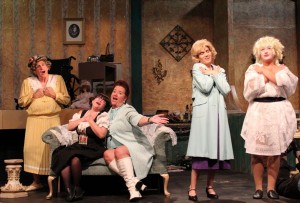 Happened to Baby Jane: A Parody of the Horror’
Happened to Baby Jane: A Parody of the Horror’ - Cindi Heimberg part of cast of ‘Whatever Happened to Baby Jane: A Parody of the Horror’
- Eren Sisk in cast of Lab’s ‘Whatever Happened to Baby Jane: A Parody of the Horror’
- There is nothing little about Yanci de la Roz’s portrayal of Jane in ‘Baby Jane’ parody
- Kayleigh O’Connell is Elvira, the Husdson Sisters’ housekeeper














 Tom Hall is both an amateur artist and aspiring novelist who writes art quest thrillers. He is in the final stages of completing his debut novel titled "Art Detective," a story that fictionalizes the discovery of the fabled billion-dollar Impressionist collection of Parisian art dealer Josse Bernheim-Jeune, thought by many to have perished during World War II when the collection's hiding place, Castle de Rastignac in southern France, was destroyed by the Wehrmacht in reprisal for attacks made by members of the Resistance operating in the area. A former tax attorney, Tom holds a bachelor's degree as well as both a juris doctorate and masters of laws in taxation from the University of Florida. Tom lives in Estero, Florida with his fiancee, Connie, and their four cats.
Tom Hall is both an amateur artist and aspiring novelist who writes art quest thrillers. He is in the final stages of completing his debut novel titled "Art Detective," a story that fictionalizes the discovery of the fabled billion-dollar Impressionist collection of Parisian art dealer Josse Bernheim-Jeune, thought by many to have perished during World War II when the collection's hiding place, Castle de Rastignac in southern France, was destroyed by the Wehrmacht in reprisal for attacks made by members of the Resistance operating in the area. A former tax attorney, Tom holds a bachelor's degree as well as both a juris doctorate and masters of laws in taxation from the University of Florida. Tom lives in Estero, Florida with his fiancee, Connie, and their four cats.